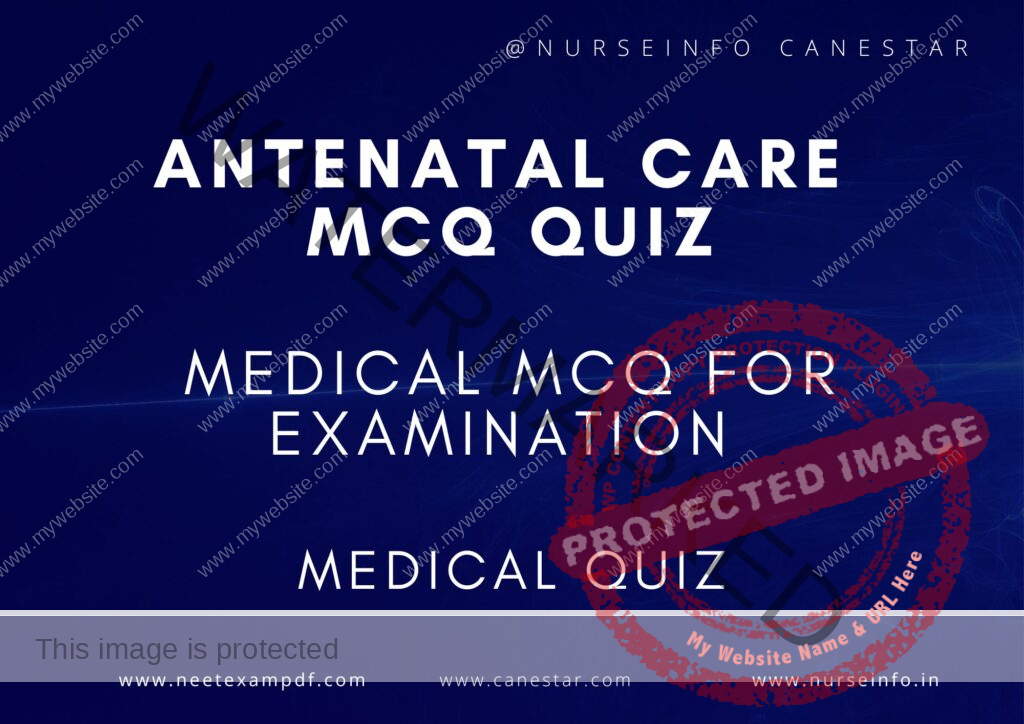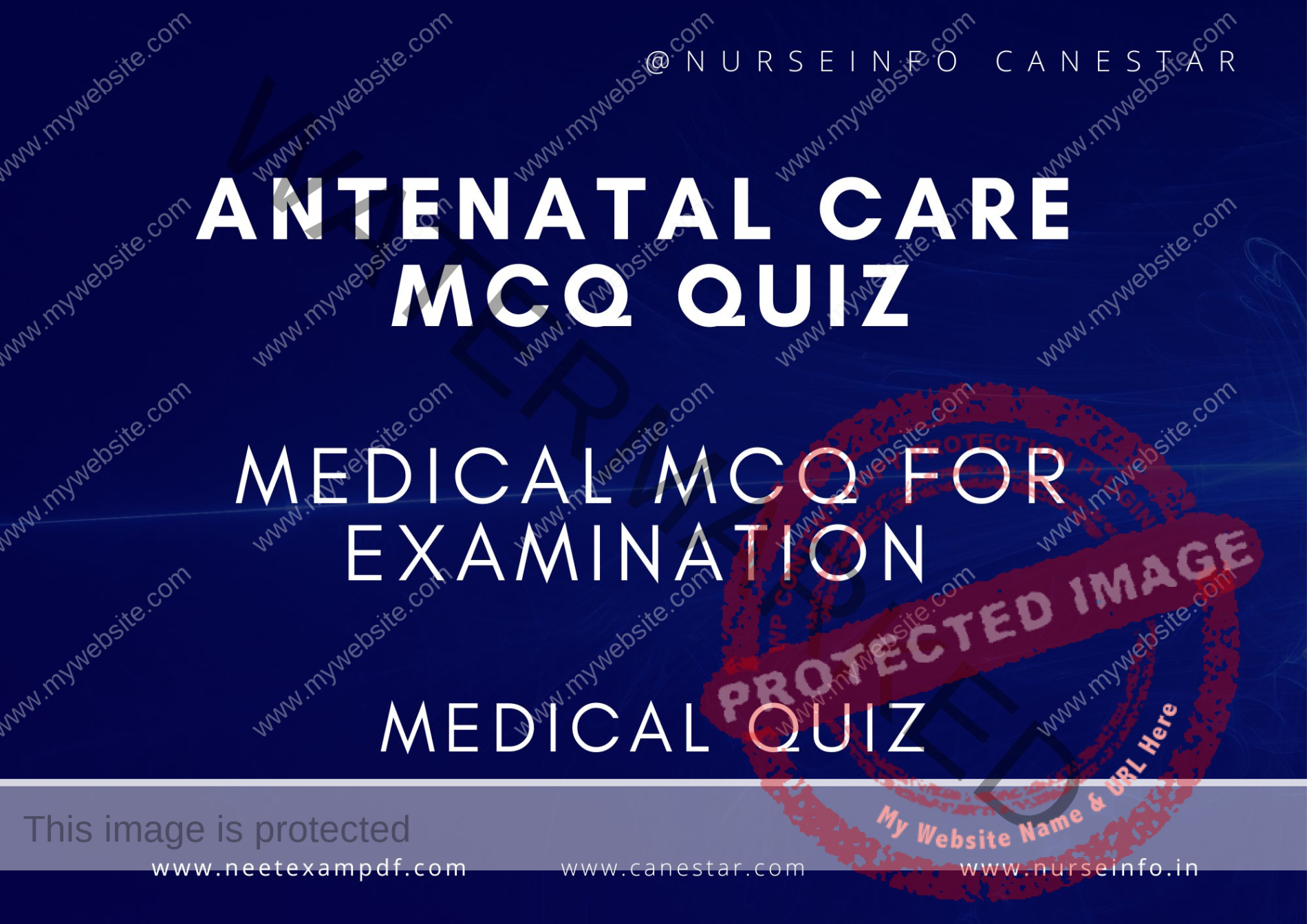MULTIPLE CHOICE QUESTIONS ON ANTENATAL CARE QUIZ – MCQS WITH RATIONALE ANSWER – OBG QUESTIONS
MCQ FOR ANTENATAL CARE QUIZ
These mcqs are prepared exclusively for medical professionals for exam preparation. MCQ is helpful to remember the concept on antenatal care mcq quiz. This multiple choice questions are helpful for preparation for DHA, PROMETRIC, MOH, HAAD, NCLEX, Medical and Nursing EXAMINATION
ANTENATAL CARE MCQ QUIZ
1. Which of the following is the most reliable indicator of fetal well-being in the third trimester?
A. Maternal weight gain
B. Fetal heart rate monitoring
C. Fundal height measurement
D. Maternal blood pressure
Answer: B. Fetal heart rate monitoring
Rationale: Fetal heart rate monitoring provides direct information about fetal well-being, especially when combined with non-stress tests and biophysical profiles.
2. At what gestational age is the nuchal translucency scan typically performed?
A. 6-8 weeks
B. 10-12 weeks
C. 11-14 weeks
D. 15-18 weeks
Answer: C. 11-14 weeks
Rationale: The nuchal translucency scan is performed between 11 and 14 weeks of gestation to screen for chromosomal abnormalities like Down syndrome.
3. Which of the following is a common sign of preeclampsia?
A. Bradycardia
B. Hypotension
C. Proteinuria
D. Hypoglycemia
Answer: C. Proteinuria
Rationale: Preeclampsia is characterized by high blood pressure and proteinuria after 20 weeks of gestation.
4. Which vaccination is recommended during every pregnancy to protect newborns from pertussis?
A. MMR
B. Influenza
C. Tdap
D. Hepatitis B
Answer: C. Tdap
Rationale: The Tdap vaccine (tetanus, diphtheria, and pertussis) is recommended during each pregnancy, ideally between 27 and 36 weeks of gestation.
5. What is the recommended daily intake of folic acid for a woman planning pregnancy?
A. 200 mcg
B. 400 mcg
C. 600 mcg
D. 800 mcg
Answer: B. 400 mcg
Rationale: A daily intake of 400 mcg of folic acid is recommended to reduce the risk of neural tube defects in the developing fetus.
6. Which of the following is a contraindication to breastfeeding?
A. Mastitis
B. HIV infection
C. Hepatitis B infection
D. Maternal fever
Answer: B. HIV infection
Rationale: HIV infection is a contraindication to breastfeeding in settings where safe and affordable alternatives are available, to prevent mother-to-child transmission.
7. When is the oral glucose tolerance test (OGTT) typically performed during pregnancy?
A. 8-12 weeks
B. 16-20 weeks
C. 24-28 weeks
D. 32-36 weeks
Answer: C. 24-28 weeks
Rationale: The OGTT is usually performed between 24 and 28 weeks to screen for gestational diabetes.
8. Which of the following is the most appropriate initial management for a pregnant woman with asymptomatic bacteriuria?
A. Observation
B. Increased fluid intake
C. Antibiotic therapy
D. Cranberry juice
Answer: C. Antibiotic therapy
Rationale: Asymptomatic bacteriuria in pregnancy should be treated with antibiotics to prevent pyelonephritis and potential complications.
9. What is the primary purpose of administering Rh immunoglobulin (RhoGAM) to an Rh-negative pregnant woman?
A. To treat anemia
B. To prevent Rh sensitization
C. To enhance fetal growth
D. To reduce the risk of preeclampsia
Answer: B. To prevent Rh sensitization
Rationale: Rh immunoglobulin is given to Rh-negative pregnant women to prevent the development of antibodies against Rh-positive fetal red blood cells.
10. What is the recommended frequency of antenatal visits after 36 weeks of gestation in a low-risk pregnancy?
A. Every week
B. Every two weeks
C. Monthly
D. As needed
Answer: A. Every week
Rationale: After 36 weeks, weekly visits help monitor maternal and fetal well-being closely as the pregnancy approaches term.
11. Which of the following is the best initial test to evaluate suspected ectopic pregnancy?
A. MRI
B. CT scan
C. Transvaginal ultrasound
D. Amniocentesis
Answer: C. Transvaginal ultrasound
Rationale: Transvaginal ultrasound is the preferred initial test to evaluate for ectopic pregnancy due to its high sensitivity and specificity.
12. Which of the following conditions is associated with polyhydramnios?
A. Oligohydramnios
B. Neural tube defects
C. Gestational diabetes
D. Placenta previa
Answer: C. Gestational diabetes
Rationale: Polyhydramnios, or excessive amniotic fluid, is often associated with gestational diabetes due to increased fetal urine production.
13. Which hormone is primarily responsible for maintaining pregnancy after implantation?
A. Estrogen
B. Progesterone
C. Oxytocin
D. Prolactin
Answer: B. Progesterone
Rationale: Progesterone is crucial for maintaining the uterine lining and preventing contractions during pregnancy.
14. Which of the following is a common risk factor for preterm labor?
A. Singleton pregnancy
B. Low maternal age
C. History of preterm birth
D. Increased body mass index (BMI)
Answer: C. History of preterm birth
Rationale: A history of preterm birth is a significant risk factor for subsequent preterm labor and delivery.
15. Which of the following nutrients is crucial to prevent neural tube defects during early pregnancy?
A. Calcium
B. Vitamin D
C. Folic acid
D. Iron
Answer: C. Folic acid
Rationale: Adequate folic acid intake is essential in early pregnancy to prevent neural tube defects.
16. What is the normal range for fetal heart rate during the third trimester?
A. 80-120 bpm
B. 110-160 bpm
C. 140-180 bpm
D. 160-200 bpm
Answer: B. 110-160 bpm
Rationale: The normal fetal heart rate range during the third trimester is 110-160 beats per minute.
17. Which of the following is a common cause of third-trimester bleeding?
A. Molar pregnancy
B. Ectopic pregnancy
C. Placenta previa
D. Miscarriage
Answer: C. Placenta previa
Rationale: Placenta previa, where the placenta covers the cervical os, is a common cause of painless third-trimester bleeding.
18. Which of the following is the best intervention to reduce the risk of neural tube defects?
A. Increased protein intake
B. Daily folic acid supplementation
C. Regular exercise
D. Calcium supplementation
Answer: B. Daily folic acid supplementation
Rationale: Daily folic acid supplementation before conception and during early pregnancy significantly reduces the risk of neural tube defects.
19. Which of the following is the first-line treatment for gestational hypertension?
A. Bed rest
B. Antihypertensive medications
C. Low-sodium diet
D. Magnesium sulfate
Answer: B. Antihypertensive medications
Rationale: Antihypertensive medications are the first-line treatment to manage gestational hypertension and prevent complications.
20. What is the primary purpose of the non-stress test (NST) in pregnancy?
A. To measure fetal growth
B. To assess fetal heart rate patterns
C. To evaluate amniotic fluid levels
D. To check maternal blood pressure
Answer: B. To assess fetal heart rate patterns
Rationale: The NST evaluates fetal heart rate patterns and accelerations, indicating fetal well-being.


